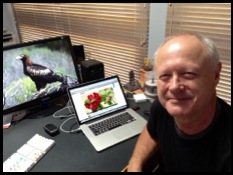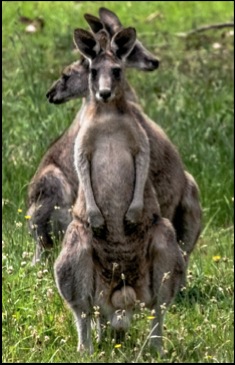Jan 2014
An issue close to my heart
30/01/14 14:41
If you have seen my video on changes in glaciation in the Himalayas you will gather that it is an issue close to my heart.
One of the things that attracted me to Joseph Hooker and his relationship with Charles Darwin was that they followed the facts even though these may have been at odds with their personal beliefs. That is what I call “Good Science” and is the underlying theme of my project. I can think of no greater scientific controversy since Darwin, Hooker and others faced off with the Church in 1860 than that currently facing climate change scientists.
Recession of glaciers in the Himalayas and elsewhere is a very topical component of the climate change debate. For example, Himalayan glacial waters are essential to the existence of more than a billion people.
My opinions are based on my own observations accompanied by examination of the drawings of Joseph Hooker as described in two of my short videos. From looking at the glacial tubes - the depression bounded by the two lateral and terminal moraines - of the glaciers on the western and eastern sides of Mt Kangchenjunga, it is not clear to me whether recession is occurring. This could be due to a possible increase in the severity of the southeast monsoon as more violent storms come up from the Bay of Bengal because of warmer sea temperatures and dump their precipitation onto the nearby Kangchenjunga massif. Such storms can result in increased flash flooding and erosion even if the total annual precipitation is constant.
On the other hand once you travel into the rain shadow of the Kangchenjunga group of mountains it is clear that severe recession has occurred. This is evident from the empty glacial tubes in the Kanglachen valley and around Nango Mountain as well as the difference between the paintings of Joseph Hooker in 1848 and what one sees today. It isn’t clear whether this recession is fairly recent or spread evenly over the past 165 years. From personal observations in Peru and the Canadian Rockies it is evident that recession of glaciers is quite dramatic in those areas. In addition almost every week we hear about the loss of sea ice in the Arctic and glacial coverage in Greenland. In 1977-78 I visited Cape Adare and the Balleny islands in the Antarctic. These places also now appear to have less sea and land ice.
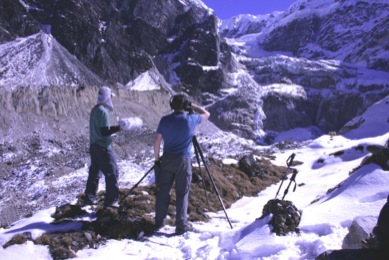
Nango Glacier now with empty glacial tube on left
In producing my project I have interviewed many prominent botanists and scientists around the world and have found without exception a great concern about climate change. I find it incomprehensible that many politicians appear not to share this concern.
As an Australian I am particularly worried. Australia is a country with a great and growing carbon footprint and the political debate and action on climate change here is almost nonexistent and is being increasingly gagged through the loss of funding to scientists working in this field. At the same time we are rushing to build enormous coalmines. Yet Australia is likely to be one of the countries most affected by a change in global temperature.
I wonder how those in power in my country do not appear to make the connection between the future of their children and grandchildren and their own lack of action.
Next week a lighter topic: How my first Joseph Hooker expedition began.
One of the things that attracted me to Joseph Hooker and his relationship with Charles Darwin was that they followed the facts even though these may have been at odds with their personal beliefs. That is what I call “Good Science” and is the underlying theme of my project. I can think of no greater scientific controversy since Darwin, Hooker and others faced off with the Church in 1860 than that currently facing climate change scientists.
Recession of glaciers in the Himalayas and elsewhere is a very topical component of the climate change debate. For example, Himalayan glacial waters are essential to the existence of more than a billion people.
My opinions are based on my own observations accompanied by examination of the drawings of Joseph Hooker as described in two of my short videos. From looking at the glacial tubes - the depression bounded by the two lateral and terminal moraines - of the glaciers on the western and eastern sides of Mt Kangchenjunga, it is not clear to me whether recession is occurring. This could be due to a possible increase in the severity of the southeast monsoon as more violent storms come up from the Bay of Bengal because of warmer sea temperatures and dump their precipitation onto the nearby Kangchenjunga massif. Such storms can result in increased flash flooding and erosion even if the total annual precipitation is constant.
On the other hand once you travel into the rain shadow of the Kangchenjunga group of mountains it is clear that severe recession has occurred. This is evident from the empty glacial tubes in the Kanglachen valley and around Nango Mountain as well as the difference between the paintings of Joseph Hooker in 1848 and what one sees today. It isn’t clear whether this recession is fairly recent or spread evenly over the past 165 years. From personal observations in Peru and the Canadian Rockies it is evident that recession of glaciers is quite dramatic in those areas. In addition almost every week we hear about the loss of sea ice in the Arctic and glacial coverage in Greenland. In 1977-78 I visited Cape Adare and the Balleny islands in the Antarctic. These places also now appear to have less sea and land ice.

Nango Glacier now with empty glacial tube on left
In producing my project I have interviewed many prominent botanists and scientists around the world and have found without exception a great concern about climate change. I find it incomprehensible that many politicians appear not to share this concern.
As an Australian I am particularly worried. Australia is a country with a great and growing carbon footprint and the political debate and action on climate change here is almost nonexistent and is being increasingly gagged through the loss of funding to scientists working in this field. At the same time we are rushing to build enormous coalmines. Yet Australia is likely to be one of the countries most affected by a change in global temperature.
I wonder how those in power in my country do not appear to make the connection between the future of their children and grandchildren and their own lack of action.
Next week a lighter topic: How my first Joseph Hooker expedition began.
Quite a move forward...
23/01/14 10:31
Quite a move forward this week with several short videos now embedded in the Joseph Hooker Correspondence Project of the Royal Botanic Gardens, Kew UK. The Kew site went live last Friday.
One of my videos is on the finding of the first western sketch of Mt Everest eight years before it was officially measured and named. Although I was aware that Joseph Hooker had seen the then unknown Mt Everest from two passes in the Eastern Himalayas, I was not aware at the time that his pencil drawing from the second pass then known as Choonjerma but now known as Sellele was in fact a very accurate drawing showing the pyramidal shape of Mt Makalu and behind it to the Northwest the double hump of Mt Everest and Lhotse. This became clear when I compared my video footage with the Hooker drawing when I was editing.
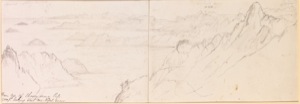
Hooker pencil drawing with Everest in background
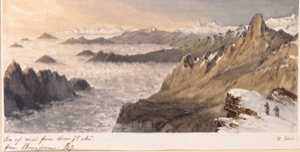
Published drawing from Hooker’s sketch by Fitch
The next time I visited Kew I mentioned to Christopher Mills, Assistant Keeper and Head of Library, Art and Archives, that I had found something special in their Archives. He seemed to be quite excited by the find and a press release was done. For about a week or was it 15 minutes I received many questions from around the world on the find and then they abruptly stopped as the news cycle passed on!
One of my videos is on the finding of the first western sketch of Mt Everest eight years before it was officially measured and named. Although I was aware that Joseph Hooker had seen the then unknown Mt Everest from two passes in the Eastern Himalayas, I was not aware at the time that his pencil drawing from the second pass then known as Choonjerma but now known as Sellele was in fact a very accurate drawing showing the pyramidal shape of Mt Makalu and behind it to the Northwest the double hump of Mt Everest and Lhotse. This became clear when I compared my video footage with the Hooker drawing when I was editing.

Hooker pencil drawing with Everest in background

Published drawing from Hooker’s sketch by Fitch
The next time I visited Kew I mentioned to Christopher Mills, Assistant Keeper and Head of Library, Art and Archives, that I had found something special in their Archives. He seemed to be quite excited by the find and a press release was done. For about a week or was it 15 minutes I received many questions from around the world on the find and then they abruptly stopped as the news cycle passed on!
Welcome to Jupe's Blog
14/01/14 14:18
Welcome to Jupe’s Blog!
Over the past several years I’ve gone from a complete amateur in the history and botanical world to an enthusiastic proponent of Sir Joseph Hooker, to me, the Unknown Hero of Evolution and probably the greatest British botanist. In my view he is still highly relevant to our changing world. This blog will be following my journey from the original idea and visit to the Royal Botanic Gardens at Kew, through the first major expedition into the Eastern Himalayas, a return visit in the monsoon to photograph rhododendrons, trips to the Antarctic, Morocco, New Zealand, the USA, the UK and various parts of Australia.
I’ll be describing my aims in making the Joseph Hooker documentary series. There will be descriptions of how to organise a major Himalayan expedition, the equipment to take, and the difficulties and fun during our expeditions. I’ll be also keeping a running record of the progress in expanding the current eight short videos on Vimeo to more than twenty. These include stories on locating the unknown first sketch of Mt Everest done by Hooker eight years before it was officially measured and named, and how his paintings of Himalayan glaciers in 1848 show how much things have changed there. I’ll be showing how he contributed to the Theory of Evolution, not only as Charles Darwin’s closest friend, but in his own right, and telling stories about some of the many plants he discovered, including one which changed the future of a Himalayan kingdom.
I’ll be talking about how difficult it is to interest broadcast networks and film financiers in such a project and why I’ve chosen to present my project via short episodes rather than a major two part TV special. I’ll be talking about life in our home in rural Australia, our native animals, birds and bushfire preparedness at this time of year. I hope that you come along for the ride.
Over the past several years I’ve gone from a complete amateur in the history and botanical world to an enthusiastic proponent of Sir Joseph Hooker, to me, the Unknown Hero of Evolution and probably the greatest British botanist. In my view he is still highly relevant to our changing world. This blog will be following my journey from the original idea and visit to the Royal Botanic Gardens at Kew, through the first major expedition into the Eastern Himalayas, a return visit in the monsoon to photograph rhododendrons, trips to the Antarctic, Morocco, New Zealand, the USA, the UK and various parts of Australia.
I’ll be describing my aims in making the Joseph Hooker documentary series. There will be descriptions of how to organise a major Himalayan expedition, the equipment to take, and the difficulties and fun during our expeditions. I’ll be also keeping a running record of the progress in expanding the current eight short videos on Vimeo to more than twenty. These include stories on locating the unknown first sketch of Mt Everest done by Hooker eight years before it was officially measured and named, and how his paintings of Himalayan glaciers in 1848 show how much things have changed there. I’ll be showing how he contributed to the Theory of Evolution, not only as Charles Darwin’s closest friend, but in his own right, and telling stories about some of the many plants he discovered, including one which changed the future of a Himalayan kingdom.
I’ll be talking about how difficult it is to interest broadcast networks and film financiers in such a project and why I’ve chosen to present my project via short episodes rather than a major two part TV special. I’ll be talking about life in our home in rural Australia, our native animals, birds and bushfire preparedness at this time of year. I hope that you come along for the ride.


